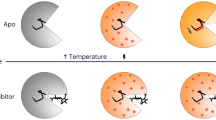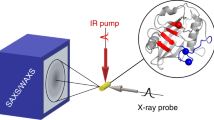Abstract
X-ray crystallography and nuclear magnetic resonance measurements provide us with atomically resolved structures of an ever-growing number of biomolecules. These static structural snapshots are important to our understanding of biomolecular function, but real biomolecules are dynamic entities that often exploit conformational changes and transient molecular interactions to perform their tasks. Nuclear magnetic resonance methods can follow such structural changes, but only on millisecond timescales under non-equilibrium conditions. Time-resolved X-ray crystallography has recently been used to monitor the photodissociation of CO from myoglobin on a subnanosecond timescale1, yet remains challenging to apply more widely. In contrast, two-dimensional infrared spectroscopy, which maps vibrational coupling between molecular groups and hence their relative positions and orientations2,3,4,5,6,7,8,9,10,11, is now routinely used to study equilibrium processes on picosecond timescales. Here we show that the extension of this method into the non-equilibrium regime12,13 allows us to observe in real time in a short peptide the weakening of an intramolecular hydrogen bond and concomitant opening of a β-turn. We find that the rate of this process is two orders of magnitude faster than the ‘folding speed limit’ established for contact formation between protein side chains14.
This is a preview of subscription content, access via your institution
Access options
Subscribe to this journal
Receive 51 print issues and online access
$199.00 per year
only $3.90 per issue
Buy this article
- Purchase on Springer Link
- Instant access to full article PDF
Prices may be subject to local taxes which are calculated during checkout




Similar content being viewed by others
References
Schotte, F. et al. Watching a protein as it functions with 150-ps time-resolved X-ray crystallography. Science 300, 1944–1947 (2003)
Fang, C. & Hochstrasser, R. M. Two-dimensional infrared spectra of the 13C:18O isotopomers of alanine residues in an α-helix. J. Phys. Chem. B 109, 18652–18663 (2005)
Wang, J., Chen, J. & Hochstrasser, R. M. Local structure of β-hairpin isotopomers by FTIR, 2D IR, and ab initio theory. J. Phys. Chem. B 110, 7545–7555 (2006)
Asbury, J. B. et al. Hydrogen bond dynamics probed with ultrafast infrared heterodyne-detected multidimensional vibrational stimulated echoes. Phys. Rev. Lett. 91, 237402 (2003)
Mukamel, S. Multidimensional femtosecond correlation spectroscopies of electronic and vibrational excitations. Annu. Rev. Phys. Chem. 51, 691–729 (2000)
Mukherjee, P., Kass, I., Arkin, I. & Zanni, M. T. Picosecond dynamics of a membrane protein revealed by 2D IR. Proc. Natl Acad. Sci. USA 103, 3528–3533 (2006)
Golonzka, O., Khalil, M., Demirdoven, N. & Tokmakoff, A. Vibrational anharmonicities revealed by coherent two-dimensional infrared spectroscopy. Phys. Rev. Lett. 86, 2154–2157 (2001)
Cowan, M. L. et al. Ultrafast memory loss and energy redistribution in the hydrogen bond network of liquid H2O. Nature 434, 199–202 (2005)
Hamm, P., Lim, M. & Hochstrasser, R. M. Structure of the amide I band of peptides measured by femtosecond nonlinear-infrared spectroscopy. J. Phys. Chem. B 102, 6123–6138 (1998)
Woutersen, S. & Hamm, P. Structure determination of trialanine in water using polarization sensitive two-dimensional vibrational spectroscopy. J. Phys. Chem. B 104, 11316–11320 (2000)
Woutersen, S. & Hamm, P. Nonlinear two-dimensional vibrational spectroscopy of peptides. J. Phys. Condens. Matter 14, R1035–R1062 (2002)
Bredenbeck, J. et al. Transient 2D-IR spectroscopy: snapshots of the nonequilibrium ensemble during the picosecond conformational transition of a small peptide. J. Phys. Chem. B 107, 8654–8660 (2003)
Bredenbeck, J., Helbing, J. & Hamm, P. Transient two-dimensional infrared spectroscopy: exploring the polarization dependence. J. Chem. Phys. 121, 5943–5957 (2004)
Bieri, O. et al. The speed limit for protein folding measured by triplet-triplet energy transfer. Proc. Natl Acad. Sci. USA 96, 9597–9601 (1999)
Kolano, C., Gomann, K. & Sander, W. Small cyclic disulfide peptides: Synthesis in preparative amounts and characterization by means of NMR and FT-IR spectroscopy. Eur. J. Org. Chem. 20, 4167–4176 (2004)
Volk, M. et al. Peptide conformational dynamics and vibrational stark effects following photoinitiated disulfide cleavage. J. Phys. Chem. B 101, 8607–8616 (1997)
Lu, H. S. M. et al. Aminothiotyrosine disulfide, an optical trigger for initiation of protein folding. J. Am. Chem. Soc. 119, 7173–7180 (1997)
Bredenbeck, J. et al. Picosecond conformational transition and equilibration of a cyclic peptide. Proc. Natl Acad. Sci. USA 100, 6452–6457 (2003)
Bredenbeck, J., Helbing, J., Kumita, J. R., Woolley, G. A. & Hamm, P. α-Helix formation in a photoswitchable peptide tracked from picoseconds to microseconds by time-resolved IR spectroscopy. Proc. Natl Acad. Sci. USA 102, 2379–2384 (2005)
Hamm, P., Ohline, S. M. & Zinth, W. Vibrational cooling after ultrafast photoisomerization of azobenzene measured by femtosecond infrared spectroscopy. J. Chem. Phys. 106, 519–529 (1997)
Pimentel, G. C. & McClellan, A. L. The Hydrogen Bond 67–141 (W. H. Freeman, San Francisco, 1960)
Nguyen, P. H., Gorbunov, R. D. & Stock, G. Photoinduced conformational dynamics of a photoswitchable peptide: a nonequilibrium molecular dynamics simulation study. Biophys. J. 91, 1224–1234 (2006)
Mohanty, D., Elber, R., Thirumalai, D., Beglov, D. & Roux, B. Kinetics of peptide folding: computer simulations of SYPFDV and peptide variants in water. J. Mol. Biol. 272, 423–442 (1997)
Mohanty, D., Elber, R. & Thirumalai, D. Probing the role of local propensity in peptide turn formation. Int. J. Quantum Chem. 80, 1125–1128 (2000)
Kubelka, J., Hofrichter, J. & Eaton, W. A. The protein folding 'speed limit'. Curr. Opin. Struct. Biol. 14, 76–88 (2004)
Sadqi, M., Fushman, D. & Munoz, V. Atom-by-atom analysis of global downhill protein folding. Nature 442, 317–321 (2006)
Yang, W. Y. & Gruebele, M. Folding at the speed limit. Nature 423, 193–197 (2003)
Satzger, H. et al. Picosecond dynamics in water-soluble azobenzene-peptides. Chem. Phys. Lett. 396, 191–197 (2004)
Acknowledgements
This work was financially supported by a Postdoctoral Research Fellowship from the Deutsche Forschungsgemeinschaft to C.K.; by grants from the SNF to P.H.; and grants from the Deutsche Forschungsgemeinschaft and the Fonds der Chemischen Industrie to W.S. Author Contributions C.K. designed the molecule together with W.S., C.K. synthesized it and ran the experiment together with J.H. C.K., J.H. and P.H. wrote the manuscript. M.K. and P.H. were responsible for the molecular dynamics simulations. 2D-IR and transient 2D-IR spectroscopy is a major theme of the group of P.H.
Author information
Authors and Affiliations
Corresponding authors
Ethics declarations
Competing interests
Reprints and permissions information is available at www.nature.com/reprints. The authors declare no competing financial interests.
Supplementary information
Supplementary Notes
This file contains Supplementary Figures 1–3, Supplementary Movie Legend, Experimental Methods, Computational Methods. (PDF 648 kb)
Supplementary Movie 1
MD simulation of the cyclic disulfide–bridged peptide cyclo(Boc–Cys–Pro–Aib–Cys–OMe). (MPG 5943 kb)
Rights and permissions
About this article
Cite this article
Kolano, C., Helbing, J., Kozinski, M. et al. Watching hydrogen-bond dynamics in a β-turn by transient two-dimensional infrared spectroscopy. Nature 444, 469–472 (2006). https://doi.org/10.1038/nature05352
Received:
Accepted:
Issue Date:
DOI: https://doi.org/10.1038/nature05352
This article is cited by
-
Chasing weakly-bound biological water in aqueous environment near the peptide backbone by ultrafast 2D infrared spectroscopy
Communications Chemistry (2024)
-
Infrared spectroscopy data- and physics-driven machine learning for characterizing surface microstructure of complex materials
Nature Communications (2020)
-
Experimental Protein Molecular Dynamics: Broadband Dielectric Spectroscopy coupled with nanoconfinement
Scientific Reports (2019)
-
Coherent two-dimensional electronic mass spectrometry
Nature Communications (2018)
-
Introduction to State-of-the-Art Multidimensional Time-Resolved Spectroscopy Methods
Topics in Current Chemistry (2018)
Comments
By submitting a comment you agree to abide by our Terms and Community Guidelines. If you find something abusive or that does not comply with our terms or guidelines please flag it as inappropriate.



